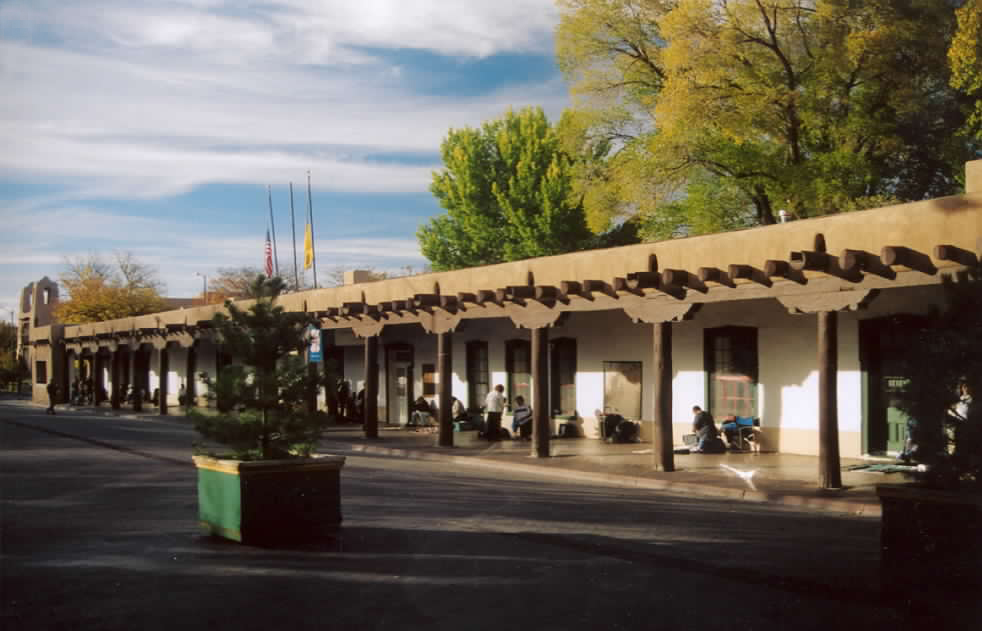- Palace of the Governors (Santa Fe, New Mexico)
Infobox_nrhp | name =Palace of the Governors
nrhp_type =nhl

caption =Palace of the Governors
location=Santa Fe, New Mexico
lat_degrees = 35 | lat_minutes = 41 | lat_seconds = 15.85 | lat_direction = N
long_degrees = 105 | long_minutes = 56 | long_seconds = 15.01 | long_direction = W
area =
built =1610
architect= Unknown
architecture= Colonial, Other
designated=October 9 ,1960 cite web|url=http://tps.cr.nps.gov/nhl/detail.cfm?ResourceId=347&ResourceType=Building
title=Palace of the Governors |accessdate=2008-06-21|work=National Historic Landmark summary listing|publisher=National Park Service]
added =October 15 ,1966 cite web|url=http://www.nr.nps.gov/|title=National Register Information System|date=2007-01-23|work=National Register of Historic Places|publisher=National Park Service]
governing_body = State
refnum=66000489 The Palace of the Governors is anadobe structure on the Plaza ofSanta Fe, New Mexico which served as the seat of government inNew Mexico for centuries. The Palace of the Governors is the oldest continuously occupied public building in theUnited States .In 1610, Pedro de Peralta, the newly appointed governor of the Spanish territory covering most of the American Southwest, began construction on the Palace of the Governors. In the following years, the Palace changed hands as the territory of
New Mexico did, seeing thePueblo Revolt of 1680, the Spanish reconquest from 1693 to 1694, Mexican independence in 1821, and finally American possession in 1846.The Palace originally served as the seat of government of the Spanish colony of Nuevo Mexico, which at one time comprised the present-day states of
Texas ,Arizona ,Utah ,Colorado ,Nevada ,California , andNew Mexico . After theMexican War of Independence , the Mexican Province of New Mexico was administered from the Palace of the Governors. When New Mexico was annexed as a U.S. territory, the Palace became New Mexico's first territorial capitol. During theAmerican Civil War , the building also briefly served as theConfederate Army 's regional headquarters.Lew Wallace wrote the final parts of his book "" in this building while serving as territorial governor in the late 1870's. He remembered later in life that it was at night, during a severe thunderstorm in the spring of 1879, after returning from a tense meeting withBilly the Kid in Lincoln County, when he wrote the climacticCrucifixion scenes of the novel. Wallace worked by the light of a shaded lamp in the shuttered governor's study, fearing a bullet from outside over the tensions surrounding theLincoln County War .Since 1909, when the New Mexico state legislature established the Museum of New Mexico, the Palace of the Governors has served as the site of the state history museum. Currently, the Palace is one of eight museums overseen by the
New Mexico Department of Cultural Affairs .It was declared a
National Historic Landmark in 1960.citation|title=PDFlink| [http://pdfhost.focus.nps.gov/docs/NHLS/Text/66000489.pdf National Historic Landmark Inventory/Nomination: Palace of the Governors] |32 KB|date=1999 |author=Corinne P. Sze and Patti Henry |publisher=National Park Service and PDFlink| [http://pdfhost.focus.nps.gov/docs/NHLS/Photos/66000489.pdf "Accompanying photos, exterior and interior, from 19"] |32 KB]In 2007, following an extensive archaeological excavation on the land immediately north of the Palace, construction of the [http://www.nmhistorymuseum.org New Mexico History Museum] began adjacent to the Palace building. The new history museum, when opened in 2009, will include interpretive exhibitions on New Mexico's colonial past housed within the Palace of the Governors building.
It is included with the
Santa Fe Historic District , and is located at Palace Avenue and Santa Fe Plaza.ee also
*
Oldest buildings in America References
External links
* [http://www.palaceofthegovernors.org Palace of the Governors Museum] housed in the Palace of the Governors building
Wikimedia Foundation. 2010.
